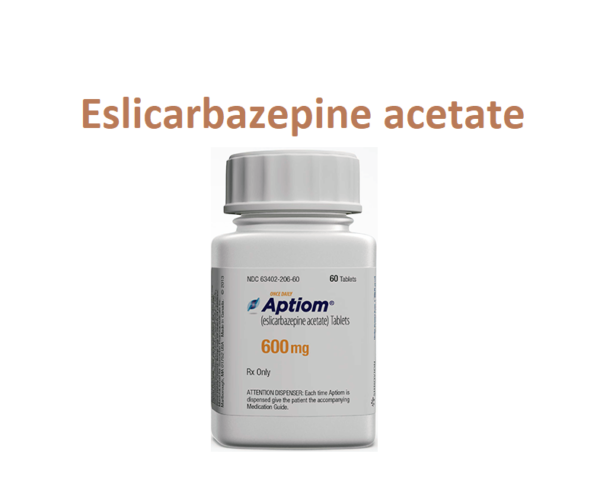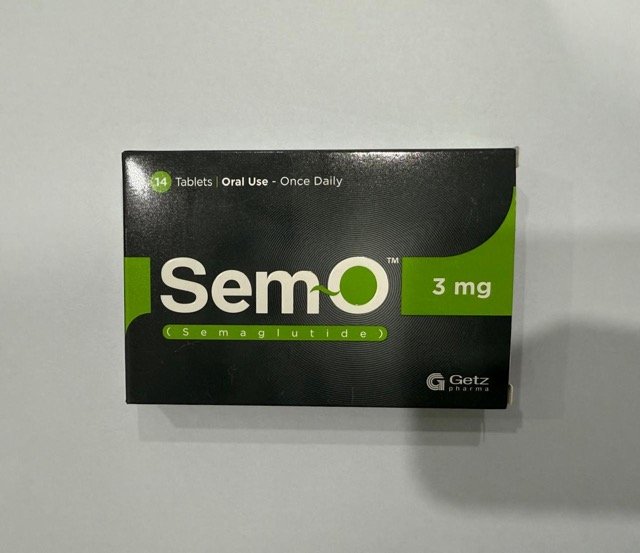In order to treat partial-onset seizures, eslicarbazepine acetate (Aptiom) is transformed into its active form, eslicarbazepine, which is administered either alone or as a supplement to other medications.
Eslicarbazepine (Aptiom) Uses:
-
Partial-onset seizures (epilepsy):
- Used either alone or in conjunction with other therapies to treat partial-onset seizures in adults and children who are at least 4 years old.
Eslicarbazepine (Aptiom) Dose in Adults
Eslicarbazepine (Aptiom) Dose in the Partial-onset seizures (epilepsy):
-
Monotherapy:
- Oral: Initial: 400 mg once in a day;
- may initiate treatment at 800 mg once in a day if seizure reduction outweighs the risk of adverse reactions during initiation.
- Increase in 400 mg to 600 mg weekly segments depending on clinical response and tolerability
- Maintenance: 800 mg to 1,600 mg once in a day.
- Note: Consider 800 mg once in a day for maintenance therapy in patients not tolerating 1,200 mg once daily.
-
Adjunctive therapy:
- Oral: Initial: 400 mg once in a day;
- may initiate treatment at 800 mg once in a day if seizure reduction outweighs the risk of adverse reactions during initiation.
- Increase in 400 mg to 600 mg weekly intervals, depending on clinical response and tolerability.
- Maintenance: 800 mg to 1,600 mg once in a day.
- Note: Consider 1,600 mg once in a day for maintenance therapy in patients not achieving response on 1,200 mg daily dosage.
Dosage adjustment with concomitant antiepileptic drugs (AEDs):
-
Adjunctive therapy:
- Carbamazepine:
- Dose adjustment of eslicarbazepine or carbamazepine may be needed dependent on efficacy or tolerability.
- Other enzyme-inducing antiepileptic drugs (eg, primidone, phenobarbital, phenytoin):
- The dosage of eslicarbazepine may need to be increased.
- Oxcarbazepine:
- Concomitant use is not recommended.
- Carbamazepine:
Eslicarbazepine (Aptiom) Dose in Children
Eslicarbazepine (Aptiom) Dose in partial-onset Seizures (monotherapy or adjunctive):
-
Children ≥4 years and Adolescents ≤17 years: Oral:
- 11 to 21 kg:
- Initial dose: 200 mg once daily; may be increased by no more than 200 mg per day per week, titrating according to clinical response and tolerability;
- maximum daily dose: 600 mg;
- maintenance dose: 400 to 600 mg once day
- 22 to 31 kg:
- Initial dose: 300 mg once daily; may be increased by no more than 300 mg per day per week, titrating according to clinical response and tolerability;
- maximum daily dose: 800 mg;
- maintenance dose: 500 to 800 mg once day
- 32 to 38 kg:
- Initial dose: 300 mg once daily; may be increased by no more than 300 mg per day per week, titrating according to clinical response and tolerability;
- maintenance dose: 600–900 mg
- >38 kg:
- Initial dosage is 400 mg once daily; it may be increased in weekly increments by no more than 400 mg per day, depending on the clinical response and tolerability;
- Maximum daily dose: 1,200 mg; maintenance dose: 800 to 1,200 mg once daily.
- 11 to 21 kg:
-
Adolescents ≥18 years:
- Oral: Initial dose is 400 mg once daily; if seizure reduction overcomes the risk of side effects at commencement, dose may increase to 800 mg once day.
- titrate dose based on clinical response and tolerability, and may be increased in weekly increments of 400 to 600 mg daily;
- The maintenance dose is between 800 and 1,600 mg taken once daily; the daily maximum is 1,600 mg.
Eslicarbazepine (Aptiom) Dosage adjustment with concomitant antiepileptic drugs (AEDs):
-
Children ≥4 years and Adolescents:
-
Adjunctive therapy:
- Carbamazepine:
- Based on effectiveness and tolerability, eslicarbazepine or carbamazepine dosage adjustments may be necessary.
- Other enzyme-inducing antiepileptic drugs (eg, primidone, phenobarbital, phenytoin):
- Eslicarbazepine dosage may need to be increased.
- Oxcarbazepine:
- Concurrent use is not advised.
- Carbamazepine:
-
Eslicarbazepine (Aptiom) Pregnancy Risk Category: N (Not defined)
- Animal reproduction studies have shown that adverse events can be observed.
- Eslicarbazepine can lower plasma levels of hormonal contraceptives. Women with reproductive potential should consider alternative or additional nonhormonal contraceptives.
Use of eslicarbazepine while breastfeeding
- It is excreted from breast milk.
- According to the manufacturer breastfeeding during therapy is a decision that should be made after considering the risks to infants and the benefits to mothers.
Eslicarbazepine (Aptiom) Dose in Kidney Disease:
-
Mild impairment (CrCl = 50 to 80 mL/minute).
- The manufacturer's labeling does not contain any dosage adjustments. Systemic exposure rose to 62% after a single 800mg dose.
-
Moderate to severe renal impairment (CrCl = 50mL/minute).
- Reducing initial, maintenance, and titration dosages by 50%; may base titration or maintenance dosage adjustments on clinical responses.
-
End-stage renal disease (ESRD), hemodialysis.
- The manufacturer's labeling does not provide any dosage adjustments; be careful. Repeated dialysis will remove metabolites.
Eslicarbazepine (Aptiom) Dose in Liver disease:
-
Mild to moderate hepatic impairment:
- No change in dose is necessary.
-
Severe hepatic impairment:
- Use is not recommended (has not been studied).
Common Side Effects of Eslicarbazepine (Aptiom):
-
Central Nervous System:
- Dizziness
- Drowsiness
- Headache
-
Gastrointestinal:
- Nausea
-
Ophthalmic:
- Diplopia
Less Common Side Effects Of Eslicarbazepine (Aptiom):
-
Cardiovascular:
- Hypertension
- Peripheral Edema
-
Central Nervous System:
- Fatigue
- Cognitive Dysfunction
- Ataxia
- Vertigo
- Depression
- Equilibrium Disturbance
- Falling
- Abnormal Gait
- Insomnia
- Dysarthria
- Memory Impairment
-
Dermatologic:
- Skin Rash
-
Endocrine & Metabolic:
- Hyponatremia
-
Gastrointestinal:
- Vomiting
- Diarrhea
- Abdominal Pain
- Constipation
- Gastritis
-
Genitourinary:
- Urinary Tract Infection
-
Neuromuscular & Skeletal:
- Tremor
- Weakness
-
Ophthalmic:
- Blurred Vision
- Decreased Visual Acuity
- Nystagmus
-
Respiratory:
- Cough
Side effects of Eslicarbazepine (Aptiom) (Frequency not defined):
-
Endocrine & Metabolic:
- Hypercholesterolemia
- Hypochloremia (Concurrent With Hyponatremia)
- Increased LDL Cholesterol
- Increased Serum Triglycerides
-
Hematologic & Oncologic:
- Decreased Hematocrit
- Decreased Hemoglobin
-
Neuromuscular & Skeletal:
- Increased Creatine Phosphokinase
Contraindications to Eslicarbazepine (Aptiom):
- Hypersensitivity to eslicarbazepine, oxcarbazepine, or any other formulation component
Canadian labeling: Additional contraindications not in US labeling
- Carmazepine hypersensitivity
- a second- or third-degree atrioventricular block's history or existence
Warnings and precautions
-
CNS effects
- Dose-dependent CNS-related adverse effects have been reported with use. The most severe were cognitive symptoms (eg amnesia and confusional state, speech disorder and memory impairment, disturbance of attention, slowness in thought, disorientation and psychomotor retardation), dizziness or fatigue, somnolence, fatigue, dizziness, coordination abnormalities (eg balance disorder, gait disorder, ataxia and vertigo), and visual changes (eg diplopia, blurred vision, and impaired vision
- Patients over 60 years old and those who have been taking carbamazepine concurrently were at greater risk for visual changes, dizziness, and coordination abnormalities during titration.
- Patients taking eslicarbazepine or carbamazepine concurrently should consider dosage changes.
- When engaging in activities that call on mental clarity, such as operating machinery or operating a vehicle, patients should proceed with caution.
-
Dermatologic reactions
- There have been reports of potentially fatal and sometimes deadly dermatologic reactions, including Stevens-Johnson syndrome. Monitor for skin reactions and discontinue or convert to alternative therapy if necessary.
- Patients with previous dermatologic reactions to carbamazepine or eslicarbazepine should not use this product.
-
Hematologic effects
- Reports have included cases of leukopenia, pancytopenia and agranulocytosis.
- If you have hematologic abnormalities, consider quitting eslicarbazepine.
-
Hepatic effects
- Reports have indicated hepatic effects that range from mild to moderate transaminase elevations (more than 3x the upper limit normal) to rare concomitant elevations total bilirubin levels (more than 2x the upper limit normal).
- Do baseline liver laboratory tests.
- Patients with jaundice, or any other sign of liver injury should be stopped.
-
Hypersensitivity reactions
- If symptoms persist, discontinue use immediately.
- Rare cases of anaphylaxis or angioedema have been documented.
- Patients who have had anaphylactic reactions to eslicarbazepine or Oxcarbazepine in the past should be avoided.
-
Hyponatremia
- Hyponatremia can be clinically significant (serum sodium less that 125 mg/L) or concurrent hypochloremia.
- Controlled studies revealed that effects occurred during the first 8 weeks (as early as 3 days after therapy began), were dose-related, and vanished without continued treatment within a few days.
- The severity of hyponatremia may dictate whether or not eslicarbazepine should be decreased or stopped.
- Monitoring serum sodium and/or chloride levels is a good idea, especially for patients at high risk of hyponatremia.
-
Multiorgan hypersensitivity reactions
- Multiorgan hypersensitivity responses (MOH), also known as potentially dangerous, occasionally fatal drug reactions with eosinophilia or systemic symptoms (DRESS), have been reported.
- Be alert for any symptoms or indicators, such as lymphadenopathy, rash, or fever. This could also indicate the involvement of other organs, such as the liver (hepatitis), kidneys (nephritis), heart (myocarditis), etc (or myositis).
- Patients who have had a DRESS reaction to oxcarbazepine or carbamazepine in the past should not use this medication.
- If you notice any symptoms, it is important to immediately seek medical attention.
- It may be necessary to discontinue treatment and convert to an alternate form of therapy.
-
Suicidal thoughts:
- A pooled analysis of antiepileptics trials (regardless if they were indicated) revealed an increase in suicidal thoughts/behavior. The incidence rate was 0.43 percent for patients who received the drug, and 0.24 percent for patients who received placebo.
- The risk was evident as soon as the trial began and continued for at least one week. Most trials last 24 weeks.
- Patients should be monitored for any changes in behavior that could indicate depression or suicidal thoughts. If symptoms are present, patients should immediately notify their healthcare provider.
-
Thyroid function
- We have observed dose-dependent drops in serum T-3 (free and total), and T-4 (total and total) levels.
- These changes were not seen in conjunction with any other abnormal thyroid function tests, suggesting hypothyroidism.
-
Renal impairment
- Patients with decreased renal function have lower clearance.
- Patients with CrCl less than 50 mL per hour will need to adjust their dosage.
-
Hepatic impairment
- Patients with severe hepatic impairment should not use this product.
Eslicarbazepine: Drug Interaction
Note: Drug Interaction Categories:
- Risk Factor C: Monitor When Using Combination
- Risk Factor D: Consider Treatment Modification
- Risk Factor X: Avoid Concomitant Use
Risk Factor C (Monitor therapy) |
|
| Benzhydrocodone | CYP3A4 Inducers (Moderate) may decrease the serum concentration of Benzhydrocodone. Specifically, the serum concentrations of hydrocodone may be reduced. |
| CarBAMazepine | May enhance the adverse/toxic effect of Eslicarbazepine. CarBAMazepine may decrease the serum concentration of Eslicarbazepine. |
| Cladribine | It is possible that BCRP/ABCG2 Inducers will lower the level of Cladribine in the blood. |
| CloZAPine | CloZAPine's serum levels may be lowered by moderate CYP3A4 inducers. |
| Codeine | The active metabolite(s) of codeine's serum concentrations may be lowered by CYP3A4 Inducers (Moderate). |
| CYP3A4 Substrates (High risk with Inducers) | The serum concentration of CYP3A4 Substrates may drop when taking CYP3A4 Inducers (Moderate) (High risk with Inducers). |
| Doravirine | The serum concentration of doravirine may drop in response to CYP3A4 Inducers (Moderate). |
| Estriol (Systemic) | Estriol serum levels may be decreased by moderately potent CYP3A4 inducers (Systemic). |
| Estriol (Topical) | Estriol serum levels may be decreased by moderately potent CYP3A4 inducers (Topical). |
| FentaNYL | The serum concentration of FentaNYL may drop in response to CYP3A4 Inducers (Moderate). |
| Fosphenytoin | May lower the level of eslicarbazepine in the serum. (based on phenytoin research) Eslicarbazepine may raise the level of fosphenytoin in the blood. (based on phenytoin research) |
| Glecaprevir and Pibrentasvir | Glecaprevir and Pibrentasvir's serum concentrations may be affected by CYP3A4 Inducers (Moderate). |
| HYDROcodone | The serum levels of HYDROcodone may drop in response to CYP3A4 Inducers (Moderate). |
| Ibrutinib | Ibrutinib's serum levels may be decreased by CYP3A4 Inducers (Moderate). |
| Ifosfamide | The active metabolite(s) of ifosfamide may be present in lower serum quantities when CYP3A4 Inducers (Moderate) are present. The active metabolite(s) of ifosfamide may be present in higher serum concentrations when CYP3A4 Inducers (Moderate) are used. |
| Lacosamide | Antiepileptic drugs (Sodium Channel Blockers) may make lacosamide more harmful or poisonous. Particularly, there may be an increased risk for bradycardia, ventricular tachyarrhythmias, or a longer PR interval. |
| Mianserin | May diminish the therapeutic effect of Anticonvulsants. |
| Mirodenafil | CYP3A4 Inducers (Moderate) may decrease the serum concentration of Mirodenafil. |
| Naldemedine | CYP3A4 Inducers (Moderate) may decrease the serum concentration of Naldemedine. |
| NiMODipine | CYP3A4 Inducers (Moderate) may decrease the serum concentration of NiMODipine. |
| Orlistat | Could lower the serum level of anticonvulsants. |
| PHENobarbital | May lower the level of eslicarbazepine in the serum. |
| Phenytoin | May lower the level of eslicarbazepine in the serum. Eslicarbazepine may raise the level of phenytoin in the blood. |
| Primidone | May lower the level of eslicarbazepine in the serum. (based on phenobarbital research) |
| Rolapitant | The serum concentration of Rolapitant may fall in response to CYP3A4 Inducers (Moderate). |
| Rosuvastatin | Rosuvastatin's serum concentration may drop due to eslicarbazepine. |
| Simvastatin | Simvastatin's serum levels may drop if eslicarbazepine is used. |
| Warfarin | Eslicarbazepine may lower Warfarin's serum concentration. Serum concentrations of warfarin may fall specifically. |
| Zolpidem | CYP3A4 Inducers (Moderate) may lower the level of zolpidem in the blood. |
Risk Factor D (Consider therapy modification) |
|
| Brigatinib | The serum concentration of Brigatinib may fall in response to CYP3A4 Inducers (Moderate). Management: Whenever possible, avoid taking brigatinib at the same time as mild CYP3A4 inducers. After seven days of treatment with the current brigatinib dose, increase the daily dose in increments of 30 mg, up to a maximum of twice the dose. |
| Clarithromycin | The active metabolite(s) of clarithromycin may be present in higher serum quantities when CYP3A4 Inducers (Moderate) are present. It is possible for CYP3A4 Inducers (Moderate) to lower the level of clarithromycin in the blood. If a patient is receiving a CYP3A inducer, other antimicrobial therapy should be considered. Drugs that speed up the conversion of 14-hydroxyclarithromycin from clarithromycin may change the clinical action of clarithromycin and reduce its effectiveness. |
| Daclatasvir | Daclatasvir's serum levels may be lowered by moderate CYP3A4 inducers. Increase the dosage of daclatasvir to 90 mg once daily for management. |
| Erdafitinib | Erdafitinib's serum levels may be decreased by CYP3A4 Inducers (Moderate). Management: Erdafitinib dosage adjustments may be necessary. For information, see the entire monograph. |
| Estrogen Derivatives (Contraceptive) | Estrogen derivatives' serum levels may be reduced by eslicarbazepine (Contraceptive). Management: Women who are capable of having children should think about non-hormonal birth control alternatives. |
| GuanFACINE | GuanFACINE serum levels may be decreased by CYP3A4 Inducers (Moderate). Treatment: When starting guanfacine in a patient receiving a moderate CYP3A4 inducer, increase the guanfacine dose by up to a factor of two. If a patient is already taking guanfacine and a moderate CYP3A4 inducer is started, gradually increase the guanfacine dose over the course of 1 to 2 weeks. |
| Lorlatinib | CYP3A4 Inducers (Moderate) may enhance the hepatotoxic effect of Lorlatinib. CYP3A4 Inducers (Moderate) may decrease the serum concentration of Lorlatinib. Management: Avoid use of lorlatinib with moderate CYP3A4 inducers. If such a combination must be used, monitor AST, ALT, and bilirubin within 48 hours of starting the combination and at least three times within the first week of combined use. |
| Lurasidone | Lurasidone's serum levels may be reduced by moderate CYP3A4 inducers. Management: If provided with moderate CYP3A4 inducers for seven or more days, watch for any diminished effects of the lurasidone and consider raising the dose. |
| Mefloquine | May reduce an anticonvulsant's therapeutic impact. Anticonvulsant serum concentrations may be reduced by mefloquine. Treatment: Mefloquine should not be used to prevent malaria in those who have a history of convulsions. With concurrent use, closely monitor anticonvulsant concentrations and therapeutic response. |
| Palbociclib | Palbociclib's serum levels may be decreased by moderate CYP3A4 inducers. Management: The Canadian label advises against using mild CYP3A4 inducers, however the US label makes no particular advice on their use. |
| Perampanel | The serum concentration of Perampanel may be decreased by CYP3A4 Inducers (Moderate). When using perampanel alongside strong and moderate CYP3A4 inducers, the beginning dose should be increased to 4 mg/day. |
| Progestins (Contraceptive) | Eslicarbazepine may lower progestin serum concentrations (Contraceptive). Management: For women who are capable of having children, alternative, non-hormonal methods of birth control should be taken into account. |
Risk Factor X (Avoid combination) |
|
| Abemaciclib | Abemaciclib's serum levels may be reduced by moderate CYP3A4 inducers. |
| Antihepaciviral Combination Products | Antihepaciviral Combination Products' serum concentration may be decreased by CYP3A4 Inducers (Moderate). |
| Asunaprevir | Asunaprevir's serum levels may be decreased by CYP3A4 Inducers (Moderate). |
| Axitinib | Axitinib's serum levels may be decreased by CYP3A4 Inducers (Moderate). |
| Bedaquiline | CYP3A4 Inducers (Moderate) may decrease the serum concentration of Bedaquiline. |
| Bosutinib | CYP3A4 Inducers (Moderate) may decrease the serum concentration of Bosutinib. |
| Cobimetinib | CYP3A4 Inducers (Moderate) may decrease the serum concentration of Cobimetinib. |
| Dasabuvir | CYP3A4 Inducers (Moderate) may decrease the serum concentration of Dasabuvir. |
| Deflazacort | CYP3A4 Inducers (Moderate) may decrease serum concentrations of the active metabolite(s) of Deflazacort. |
| Elbasvir | CYP3A4 Inducers (Moderate) may decrease the serum concentration of Elbasvir. |
| Encorafenib | CYP3A4 Inducers (Moderate) may decrease the serum concentration of Encorafenib. |
| Flibanserin | CYP3A4 Inducers (Moderate) may decrease the serum concentration of Flibanserin. |
| Grazoprevir | CYP3A4 Inducers (Moderate) may decrease the serum concentration of Grazoprevir. |
| Neratinib | CYP3A4 Inducers (Moderate) may decrease the serum concentration of Neratinib. |
| Nisoldipine | CYP3A4 Inducers (Moderate) may decrease the serum concentration of Nisoldipine. |
| Olaparib | CYP3A4 Inducers (Moderate) may decrease the serum concentration of Olaparib. |
| OXcarbazepine | Eslicarbazepine may enhance the adverse/toxic effect of OXcarbazepine. |
| Ranolazine | CYP3A4 Inducers (Moderate) may decrease the serum concentration of Ranolazine. |
| Simeprevir | CYP3A4 Inducers (Moderate) may decrease the serum concentration of Simeprevir. |
| Sonidegib | CYP3A4 Inducers (Moderate) may decrease the serum concentration of Sonidegib. |
| Velpatasvir | CYP3A4 Inducers (Moderate) may decrease the serum concentration of Velpatasvir. |
| Venetoclax | CYP3A4 Inducers (Moderate) may decrease the serum concentration of Venetoclax. |
Monitoring parameters:
- Seizure frequency
- Baseline liver enzymes
- Patients receiving maintenance therapy, especially if they are taking other medications that decrease sodium levels or have hyponatremia symptoms, should have their serum sodium and/or chloride measured.
- CNS depression symptoms include disturbances in gait and coordination as well as dizziness and somnolence.
- Visual changes
- Hypersensitivity reactions.
- Suicidality monitoring (eg suicidal thoughts and behavioral changes, depression).
- As adjunctive therapy, the serum levels of any concomitant antiepileptic drug should be monitored during titration.
How to administer Eslicarbazepine (Aptiom)?
Give the medication with or without food. Crush or swallow the tablets whole.
Mechanism of action of Eslicarbazepine (Aptiom):
- Eslicarbazepine acetate can be extensively converted into eslicarbazepine.
- Its therapeutic actions are a result of this.
- Voltage-gated sodium channels are thought to be inhibited, while the exact mechanism is unknown.
Protein binding:
- less than 40 percent
Metabolism:
- Eslicarbazepine, a primary active metabolite, and the lesser active metabolites (R)-licarbazepine and oxcarbazepine are produced quickly and widely by hydrolytic first-pass metabolism. Active metabolites are then converted to inactive glucuronides.
Bioavailability:
- more than 90 percent
Half-life elimination:
- Pediatric patients 4 to 17 years: 10 to 16 hours;
- Adults: 13 to 20 hours
Time to peak:
- Eslicarbazepine:
- Pediatric patients 4 to 17 years: 1 to 3 hours;
- Adults: 1 to 4 hours
Excretion:
- Urine (90 percent; ~66 percent eslicarbazepine, ~33 percent glucuronide conjugate forms, ~10% other minor metabolites)
International Brand Names of Eslicarbazepine:
- Aptiom
- Deprexazin
- Exalief
- Lepsylief
- Normictal
- Zebinix
- Zefretol
- Episabazin
- Eslicar
- Eslicarba
- Eslify
- Eslizen
Eslicarbazepine Brand Names in Pakistan:
There is no brand available in Pakistan.



.jpeg)



